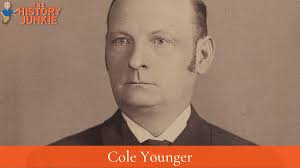7 Facts You Didn’t Know About Cole Younger
Cole Younger is one of the most infamous outlaws of the American Wild West, known primarily for his association with the James-Younger Gang. While many stories focus on his bank and train robberies, there are several lesser-known aspects of his life that reveal a complex and intriguing character.
Here are seven facts about Cole Younger that you may not know.
1. He Fought in the Civil War Before Becoming an Outlaw
Before he became an outlaw, Cole Younger was a Confederate guerrilla fighter during the American Civil War. He joined Quantrill’s Raiders, a group of pro-Confederate bushwhackers who conducted raids and ambushes in Missouri and Kansas. The war deeply affected Younger, as he witnessed violence firsthand and suffered personal losses, including the execution of his father by Union troops. This tumultuous period played a significant role in shaping his later life and contributed to his turn toward outlawry.
2. His Family Was Victimized During the War
The Younger family suffered immense hardships during the Civil War. Their home in Missouri was ransacked, and several of Cole’s siblings were left homeless. His father, Henry Washington Younger, was allegedly murdered by pro-Union forces, a tragedy that fueled Cole’s resentment toward the Union and may have influenced his decision to join Quantrill’s Raiders. The family’s suffering instilled in Cole a deep-seated desire for retribution, which likely led him to a life of crime.
3. The James-Younger Gang Was Originally a Guerrilla Unit
Most people know Cole Younger as a key member of the James-Younger Gang, but fewer are aware that the gang originally had its roots in guerrilla warfare. Many members, including Jesse and Frank James, fought as bushwhackers during the Civil War. Their transition to crime was somewhat natural, given their wartime experiences of looting and hit-and-run tactics. The gang became famous for robbing banks, trains, and stagecoaches, often claiming they were striking back at wealthy elites and corrupt institutions.
4. The Northfield Raid Was a Turning Point in His Life
One of the most famous events in Cole Younger’s life was the failed Northfield, Minnesota bank robbery in 1876. The James-Younger Gang attempted to rob the First National Bank of Northfield, but the town’s residents fought back with remarkable bravery. During the chaotic shootout, several gang members were killed, and the Younger brothers—Cole, Jim, and Bob—were badly wounded and captured. This event effectively ended the gang’s reign of terror and led to Cole spending over two decades in prison.
5. He Served 25 Years in Prison and Reformed
After his capture in Minnesota, Cole Younger was sentenced to life in prison at the Minnesota State Penitentiary. He served 25 years before being paroled in 1901. While in prison, he reportedly became a model inmate, even teaching Sunday school and working as a clerk. Upon his release, he expressed regret for his past crimes and sought a more peaceful life. His time in prison allowed him to reflect on his choices, and he often spoke about his desire to live a reformed life after gaining his freedom.
6. He Worked in Show Business After Prison
Upon his release from prison, Cole Younger capitalized on his notoriety by joining a Wild West show with Frank James. The show featured reenactments of their exploits, drawing large crowds eager to see the famous former outlaws. Although some criticized him for profiting off his criminal past, Younger saw it as a way to make an honest living. However, he eventually distanced himself from show business, opting for a quieter life in his later years.
7. He Wrote a Memoir and Lived Out His Final Years Peacefully
In his later years, Cole Younger sought to set the record straight about his life and penned a memoir titled “The Story of Cole Younger” in 1903. In his book, he recounted his experiences as a guerrilla fighter, outlaw, and prisoner, often justifying his actions as responses to injustices he and his family suffered. He spent his final years advocating for peaceful living and personal redemption, passing away in 1916 at the age of 72.
Conclusion
Cole Younger’s life was filled with adventure, violence, and ultimately redemption. While many remember him as an outlaw, his story is far more nuanced. From his days as a Confederate guerrilla to his time as a Wild West show performer and author, Younger’s life was a testament to the turbulence of post-Civil War America. His journey from lawlessness to reform remains one of the most compelling narratives of the Wild West era.





